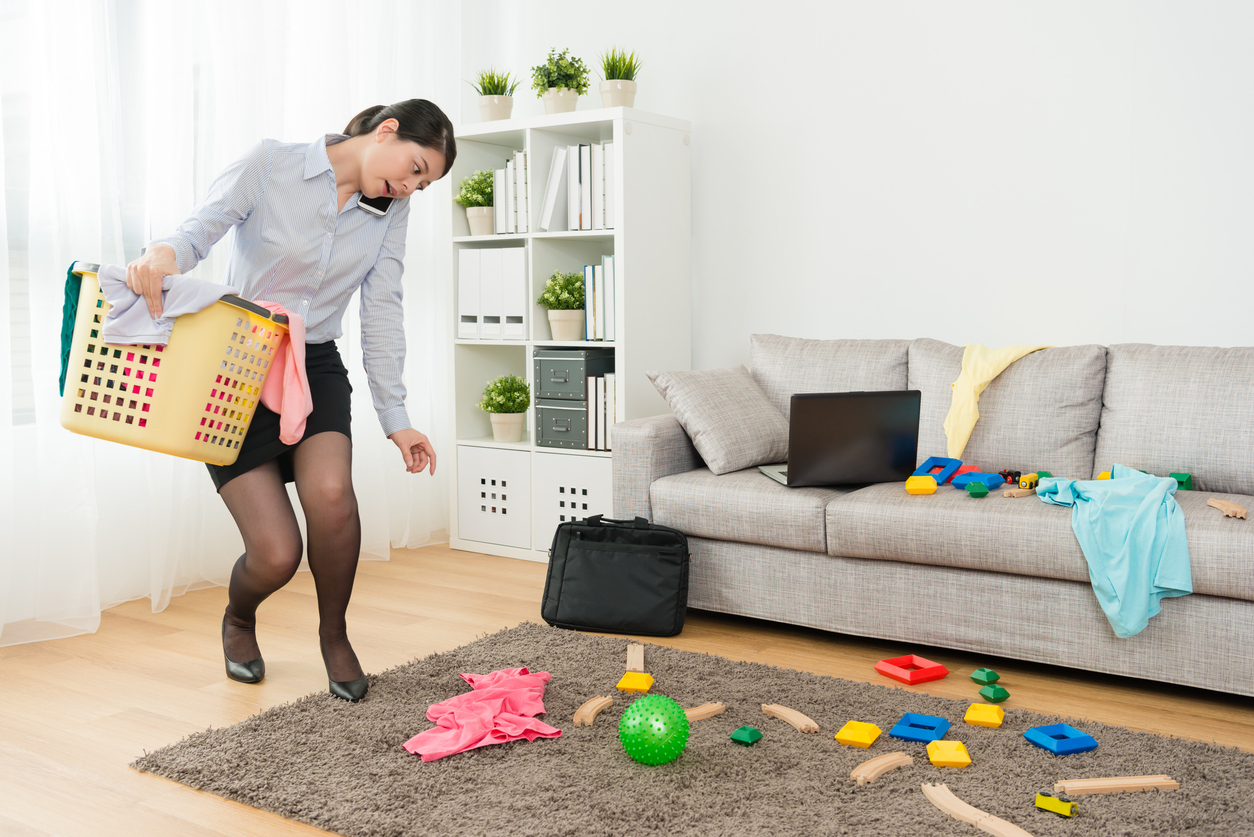
I think clutter is one of those things that just creeps up on us. We may notice a small pile on the kitchen counter on Monday and then by Friday the small pile has somehow grown into a mountain and is spilling over onto the kitchen floor. When my children were living at home there were times when I tossed things (clutter) into shopping bags and stuffed them into a closet if friends were coming over for dinner. Have you ever done that? Of course you have. I don’t think there’s a single person alive who hasn’t done that at least once. The challenge is to keep clutter under control.
What I know to be true is that small consistent routines will prevent clutter from becoming an overwhelming mess.
1. Why Clutter Builds Up
Clutter builds up when we don’t deal with the things that have accumulated regularly. It may be that the item belongs to another family member, and we’re waiting for them to come and deal with it.
Perhaps we’ve picked up a flyer or other information during the day. Maybe we’re tired and put the things aside to tackle later. Typically, when we tell ourselves we’ll do or think about something later, we’re really telling ourselves that we don’t want to do it and promptly forget all about the task.
Having solid daily routines can help us keep clutter under control with a series of tried-and-true steps to take.
2. The Habit of Resetting Spaces
Cultivate the habit of resetting the rooms or spaces in your home that are most frequently used every day.
I’m not talking about doing anything complicated or time consuming.
Rather, I’m advocating to once a day clear the kitchen counter, put things back where they belong, and tidy up so that the next day you can start fresh. If you do this every day, it won’t take long because there won’t be too much to do.
3. The Power of the One-Minute Rule
Have you heard of the one-minute rule? No? It goes like this, if a task takes less than a minute, do it right away.
This keeps clutter under control because it keeps it from accumulating.
Here’s an example: when you get the mail, put the flyers, catalogues, and any solicitations in the recycling immediately. This will leave you with the mail that needs your attention. Take this mail and put it where you will deal with it at the appropriate time.
4. Schedule Time to Declutter
Schedule time with yourself once a week to check areas in your home that tend to accumulate clutter.
In my house, shoes tend to accumulate near the front door. Why? Well, because I don’t wear shoes in my house, and I don’t always wear the same shoes. So, once a week I take the shoes back to my closet and put them away.
Maintaining this area by my front door is easy because I do this once a week. If I didn’t, I know it would become hazardous. I could trip over the accumulation of shoes.
Think about which area of your home to declutter regularly and then schedule time to attend to that space once a week. If clutter accumulates in multiple areas, then schedule several times during the week to deal with it.
5. Be a Careful Shopper
Advertisers are very clever and with the advent of artificial intelligence, they can now insert targeted ads into our social media feed and our computer as we are scrolling online.
Before you hit that ‘Buy Now’ button, review your options.
Ask yourself:
- Do I already have something like this?
- Where will I keep it?
- What will I remove to make room for this new item?
Get into the habit of pressing the pause button and thinking through these questions. This will help you to avoid impulse buys.
6. Make a Donation Box
Things turn into clutter when we decide that we don’t want or use them anymore. When that happens, we put them aside and they collect one on top of the other. We can keep clutter under control by making a donation box. Then we have a place to put things we no longer need, use, or love.
One of my clients keeps a large plastic tub in a corner at the bottom of the stairs to her basement. It is her donation box. When she comes across something she doesn’t want anymore, she puts it in the box. She takes the box to her donation site once a month, empties it, and brings it home until the next time.
7. Maintenance and Flexibility are Key
The importance of regular household maintenance cannot be underestimated. When a person takes a few minutes here and there to put things away or remove them from the home, their home stays relatively clutter free.
Flexibility is another important tool to use. Knowing that if you don’t have time (or are too tired to) reset a room at night that you can take a few minutes the next day and nothing bad is going to happen is critical for your peace of mind. Maybe a few odds and ends will pile up. That’s ok as long as you plan to take care of them.
It’s important to adjust the daily habits and routines to fit your current needs.
Conclusion
Let’s review.
The daily habits to cultivate to keep clutter under control are the one-minute rule and resetting the room/space. If you make those two things part of your daily routine you will find less and less clutter accumulating.
Why? It’s simple. You won’t be giving clutter an opportunity to pile up.
If your goal is to keep clutter under control, try implementing the one-minute rule first. When you’ve made that part of what you do, add resetting the space once a day. Taking time to build habits gradually will encourage those habits to stick.
Email me at dnqsolutions@gmail.com to schedule a free 30-minute phone conversation if you’d like to know more about how you can control clutter.
Diane N. Quintana is the owner of DNQ Solutions, LLC. She is an ADHD Organizing Specialist, a Hoarding Specialist, and a Chronic Disorganization Specialist. Diane is also an ICD Master Trainer, Certified Professional Organizer in Chronic Disorganization, Certified Professional Organizer and co-owner of Release Repurpose Reorganize LLC based in Atlanta, Georgia. She specializes in residential and home-office organizing.


These are all stellar steps to the right habits and mindset for the right routines. For me, although I do all of these things, the key is #2; once you know what “organized” is supposed to look like, resetting is easy. Everything has to have a home, and once it does, there’s no dillydallying about what to do next or where something should be placed, and I think that makes all the difference. And yes, sometimes where something belongs is in the donation box (or recycling).
I find that the more I can put on autopilot, the less chance there is that things will get out of hand. I may go through all of my papers and mail while watching TV, with a pile of discards, and even though it’ll only take a minute to walk them to the kitchen and toss things out, I probably won’t do that, but I will get everything to where it belongs during my evening process of turning off the TV and shutting things down. Keeping clutter at bay really does require good habits, but once they’re set in motion, they are incredibly powerful. Great post!
Thank you, Julie. I agree with you. Once you’ve decided where things belong – it’s a simple process.
One of the most helpful strategies I’ve found came from a book called “Totally Organized the Bonnie McCullough Way.” She called it Minimum Maintenance and it involved walking through each room once a day (or twice, if you have kids), putting things away, removing whatever doesn’t belong in that room and returning it to its correct place. It didn’t take long and it prevented the clutter from accumulating. This ties in well with what you recommend here.
Thanks, Janet. It’s the idea that if you do a little on a daily basis nothing much has a chance to gather.
Clutter is a fascinating thing. Without some routines and daily habits, it will be challenging to keep it away.
I’m big on the daily reset. There are some areas where I ‘reset’ them more than once a day. For example, after any meal, I clear the counters, dishes, and sink. Some prefer to do this daily or less often, but in my space, I generally like doing it throughout the day.
I do something I call a “quick clean.” This isn’t a deep clean but a general cleaning of the bathrooms and other areas. Wipe the sink and mirrors, scrub the toilet, and clean and dust a few surfaces. It doesn’t take long and keeps things fresher between the bigger cleanings. The daily clutter-clearing habit you described is similar. It doesn’t take long but has a positive effect on how your space feels and functions.
I do a “quick clean” in my house too, Linda – every morning! It’s nothing complicated or intense and keeps the bathrooms, kitchens and floors relatively clean. Thank you for your comment!
I am a great believer in daily resetting my living areas. Every morning, I reset my bedroom, living room, and kitchen. It only takes minutes and makes the house so much more peaceful.
Thank you, Jonda. Doing a daily reset is so quick and easy!
I love suggesting Resetting Spaces to my clients with families. Creating a daily routine of walking around the house carrying a basket and picking up items that don’t belong where they have landed, then dropping off these items in the room they belong in as you walk through the home. At least things end up in the room they belong in!
I also think Maintenance is a family affair. Having everyone participate in a 5 or 10-minute pick-up right before dinner is my favorite. That way it’s not right before bed (too tired) and sitting down to dinner is the reward (which you would do anyway). The family works as a team and everyone takes some responsibility.
I agree with you, Janet. I think everyone who lives in the home (no matter how young or old) can participate in maintenance. Many hands make light work!
I love all of these suggestions, and especially the donation box. I think having a place to immediately put things we no longer want is so helpful, especially for those who might be less inclined to go through a whole bunch of stuff at once. We set up a space in our “5th cubby” for donations, and I’ve noticed that my husband has started putting things there. Before we had that specific location, he never wanted to give anything away. But now, he will drop something there and I know it’s “okay to go.”
Thank you, Seana. I agree it’s so much easier to have a specific spot for a donation box. This way when you come across something and know you don’t want it anymore, there is a place to put it.